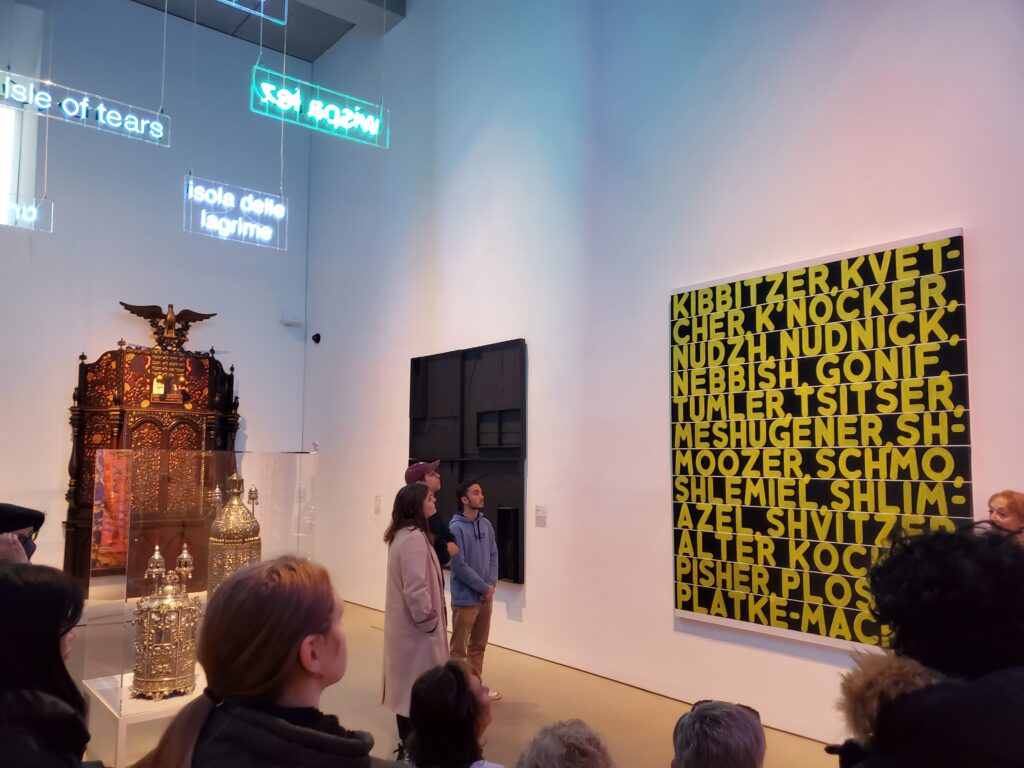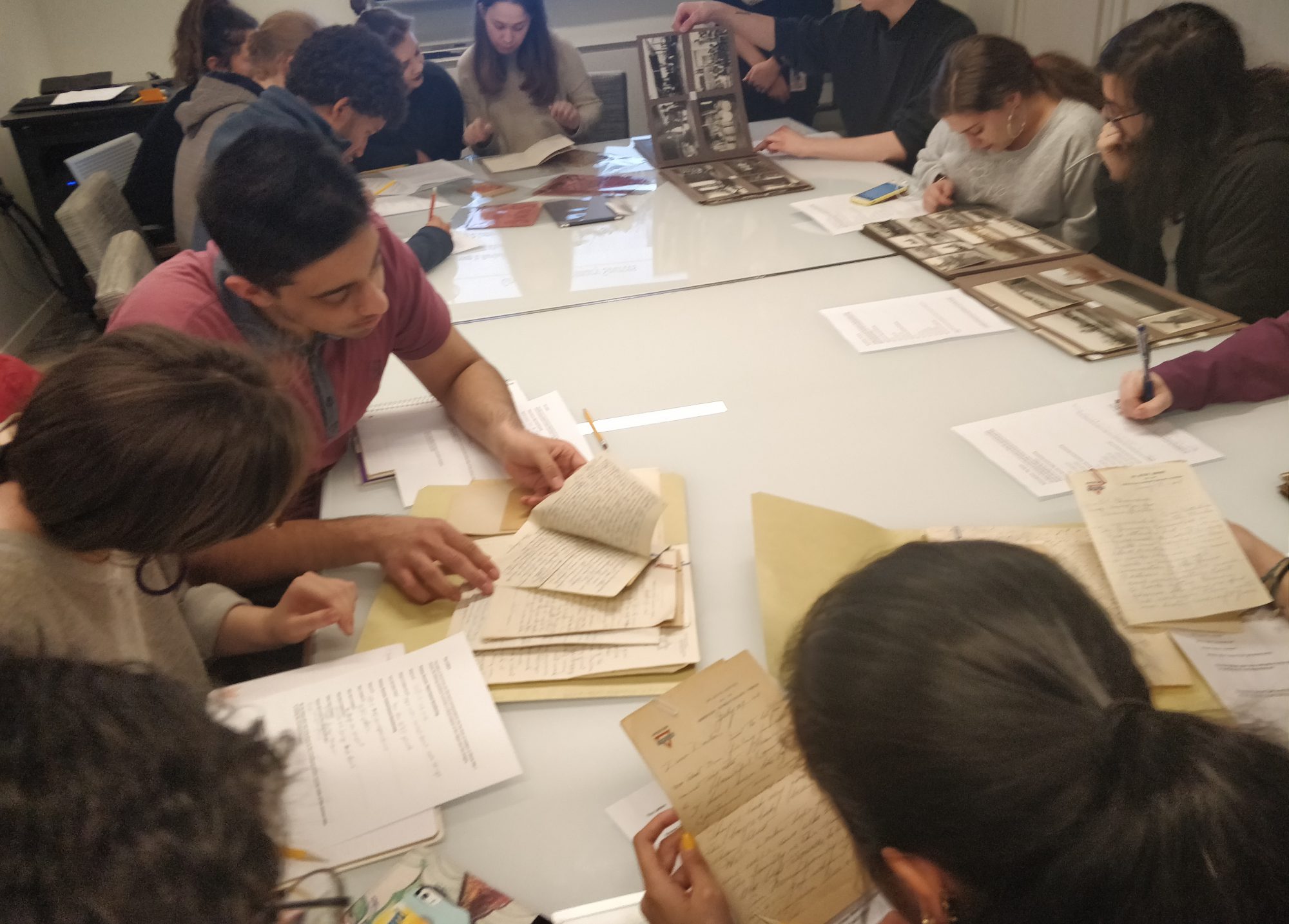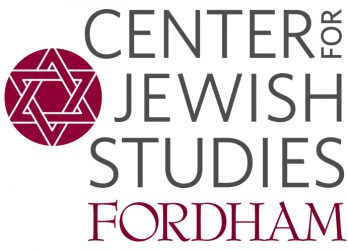Emma Reynolds FCRH’23
Immediately upon entering the Jewish Museum, the tone is clear: Holistic. On the third floor, the large main room we entered first was bright. It included art of all content and style, spanning centuries of history. The exhibit “Scenes from the Collection” was very obviously curated with a labor of adoration, with each piece in its specific place working with each piece around it to create a picture of Jewish culture that was both historical and personal, modern and contextual, saddening and rejoicing. I believe the museum was very careful to present Jewish culture as alive, not simply reduced to Jews as victims of tragedy and discrimination. This was a theme I often came back to in our course this semester, how both antisemitism and the study of antisemitism can de-personify Jews, either turning them into villains or perpetual victims. The reinstating of Jewish personhood and identity, while also acknowledging the sadness and loss that is a part of that identity, is one of the strongest statements of the museum.

These themes of connecting personal modern identity with the past was shown through many pieces and displays in the exhibit. The first collection we viewed was a case of at least a dozen Hanukkah lamps that varied wildly. From material to sentimental context, from a century to a continent, each lamp was different and reflected the personality of Jews all across place and time, united by a culture and religion. The image was so powerful. These lamps were so personal, almost a vignette or a biography of a family who had once owned it, yet the display also served to point out the longevity of the traditions that maintained this culture. Too often in the study of Jewish history, or even more so in antisemitism, the lack of a Jewish voice can prevent us from seeing a person behind every story, perpetuated myth, act of violence or gaining of citizenship. While studying the history of antisemitism, I would constantly and actively remind myself to read between the lines and remember the humanity behind every story and remember that people, demonized in these text, were also not just victims—they had full and culture-filled lives that were enriched by their community and religion. This display of Hanukkah lamps also noted the connection between religion and culture.

Another display that stuck with me was the pairing of the highly decorated portrait of Alios Itzhak by Kehinde Wiley and the Torah ark made by Abraham Shulkin next to it. The placement of these two objects, different in era, form and function, allowed us as the audience to clearly compare and understand the elements that are reformed and replicated as important motifs in Jewish art. The similarities included religious elements such as the top more decoration of the eagle and the hands gesturing in prayer, as well as intricate detail work of flowers and vines. The overlap in these pieces that are so different really emphasize the importance of history to modern Jewish art and show how modern Jews continue to root themselves in their past and in religious origins to maintain a cohesive culture. The use of religious motifs despite the nonreligious function of the piece really speaks to the importance of the religion on the culture, yet the continuation of artistic styles also supports the reverse- that there is a deeper culture and style that unites beyond religious symbolism.

These ideas are also reflective of what we discussed in class, the variation in defining what is “Jewish”, and how its ties to cultural, religious, and ethnic roots impact the contextualization of Jews in their world. While this is relevant to antisemitism, as it concerns outward perceptions of Jews and what it means to be a Jew, these are also concerns of the self and of self-identity. In the art by modern Jewish artists, physical manifestation of that self-exploration is seen in their playing with the overlap of culture and religion. In the painting by Kehinde Wiley, I think this relationship is captured perfectly, and it is aided by the side-by-side comparison to the historical Torah ark.
The art on display did not shy away from discussions of trauma and violence, however, it framed these events in the context of Jewish agency and personhood. Works we saw explored

Jewish reactions to the mass murder or attempts to understand a new reality with the knowledge of the extent of anti-Jewish hate, but they did not reduce the Jewish people to faceless victims. This reflection on the real emotion and reaction to tragedy were some of the most honest and human works of art I’ve experienced. By framing the Holocaust in this way, almost in an abstract, the viewer is allowed to focus on the humanity of the artist, and the life that they created from a tragedy.

Overall, I think this museum is remarkably well conceived and unique in its ability to remain cohesive and yet represent such a long and diasporic history. In the use of the specific works of art to contextualize each other historically or emotively, the museum was able to create a truly personable and holistic view at Jewish culture.
Emma Reynolds is a senior at Fordham College at Rose Hill. She visited the Jewish Museum as part of the values seminar on the history of antisemitism taught by Professor Magda Teter in the fall of 2022.

